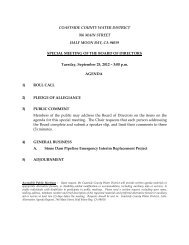Lower Pilarcitos Creek Groundwater Basin Study - Coastside ...
Lower Pilarcitos Creek Groundwater Basin Study - Coastside ...
Lower Pilarcitos Creek Groundwater Basin Study - Coastside ...
Create successful ePaper yourself
Turn your PDF publications into a flip-book with our unique Google optimized e-Paper software.
Figure 4 illustrates the areal distribution of rainfall in the Half Moon Bay area<br />
(SCVWD, 1989). The pattern of precipitation is complex, with significant variations<br />
depending on elevation and topographic setting. In general, rainfall increases from a low<br />
of about 26 inches at the coast to highs of 42 inches near <strong>Pilarcitos</strong> Lake on the<br />
northeast and 40 inches along the Kings Mountain crest on the southeast. The<br />
intervening area (crossed by Highway 92) has lower rainfall, averaging 30 inches.<br />
Evapotranspiration. Evapotranspiration (ET), the loss of water to the<br />
atmosphere through evaporation and plant transpiration, is relatively low in the study<br />
area. The California Department of Water Resources (DWR) includes the Half Moon Bay<br />
area within its Coastal Plains Heavy Fog Belt zone (DWR, no date). Reference<br />
evapotranspiration is approximately 33 inches. This ET rate refers to a well-watered turf<br />
and is applied to an individual crop type through use of a coefficient that accounts for the<br />
typical growing season of the crop and crop water consumption. Actual<br />
evapotranspiration rates from a field also are influenced by cropping and irrigation<br />
practices. The study area is marked by a variety of crops (for example, brussel sprouts,<br />
daisies, and pumpkins) and differences in cropping and irrigation practices, all of which<br />
have changed over time. Accordingly, the water balance for this report applies the<br />
reference ET rate to all crops and landscaping. This results in some overestimation of<br />
groundwater consumption.<br />
The <strong>Lower</strong> <strong>Pilarcitos</strong> <strong>Creek</strong> groundwater basin also includes extensive areas of<br />
natural vegetation, including areas of grass and shrubs along the coastal bluffs and a<br />
corridor of water-loving trees and shrubs (phreatophytes) along <strong>Pilarcitos</strong> <strong>Creek</strong>.<br />
Evapotranspiration for the natural grass and shrubs was estimated by applying monthly<br />
ET coefficients for sagebrush-grass (Stephens, 1996), which reduced the ET rate to<br />
about 22 inches per year. Phreatophytes are assumed to consume the full potential ET<br />
(Stephens, 1996).<br />
Land Use<br />
Land use in the Half Moon Bay area was mapped by the California DWR in 1977<br />
and 1987 (DWR, 1977 and 1987). For this study, the 1987 land use map was updated to<br />
current conditions (autumn 2002) through field reconnaissance. DWR land use maps<br />
provide information on the full range of land uses including natural vegetation, recreation<br />
areas, urban land uses (e.g., urban, urban residential, schools, and vacant lands), and<br />
agricultural land uses (specific crop types, irrigation status, fallow and idle lands).<br />
4



